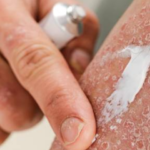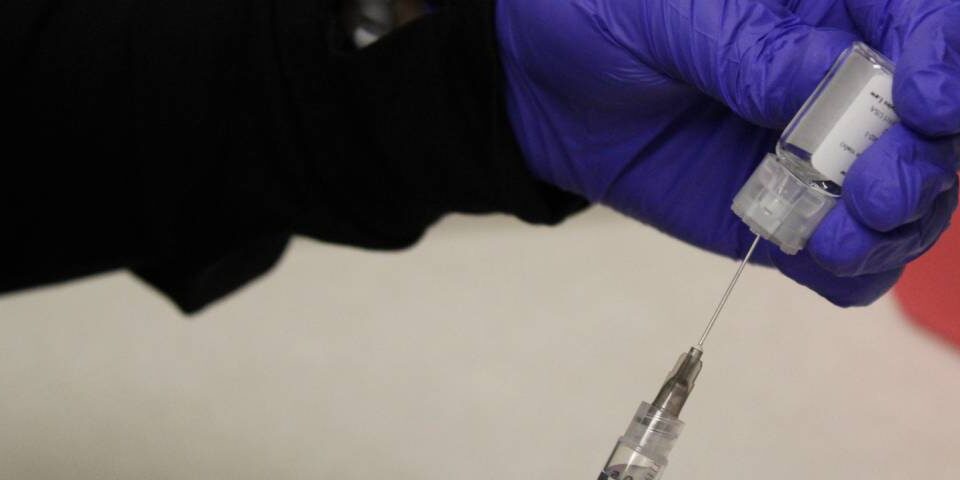
Cracking the Code on Eczema Relief: New Treatments for Eczema Clinical Trials
October 10, 2024
Gorlin Syndrome: Understanding the Condition and Exploring New Treatments
December 5, 2024Imagine waking up to find random patches of hair missing with no clear explanation—this is the reality for those living with alopecia areata. Alopecia areata is a non-contagious autoimmune disorder that triggers the immune system to attack hair follicles as if they were an infectious disease. As a result, hair follicles cannot support the hair, so it falls out, causing random bald patches. These bald patches can occur anywhere on the body, but most commonly they appear on the scalp or face. In some people, male and female alike, alopecia areata can cause complete baldness. Alopecia areata affects about 7 million people in America and about 2 percent of the global population.
Although this type of hair loss isn’t physically painful or dangerous per se, it can be emotionally and mentally debilitating, triggering anxiety and depression, and negatively impacting work, school, and social relationships. Apex Clinical Research Center is committed to helping patients with this condition get relief through effective alopecia treatment, so we are researching new, more effective treatment options. We are now participating in groundbreaking clinical trials for alopecia for which you may be eligible to participate in if you struggle with this condition.
Understanding Alopecia Areata
It’s normal for everyone to shed anywhere from 50 to 100 hairs each day. During some times of life, it may be common to shed more than that: during pregnancy and after giving birth, losing a lot of weight, during disease or illness (especially when accompanied by a high fever), or when experiencing an incredibly stressful situation. Starting or stopping some medications, like birth control, can also increase hair shedding. Alopecia is a completely different situation—it happens suddenly, with hair falling out in bunches, leaving behind coin-sized (or bigger) bald patches, with or without scarring. This is a case of the body attacking its own tissues.
What is Alopecia Areata?
The word alopecia means “baldness” and “areata” refers to its tendency to manifest in random patches of baldness in different areas. As a chronic autoimmune disease, the body’s immune system misfires, erroneously identifying hair follicles as an infectious threat like a virus or bacteria. The resulting patches can appear anywhere hair grows on the body, including eyelashes, eyebrows, scalp, etc.
Types of Alopecia
There are several different types of alopecia areata, designated depending on where on the body the hair loss is concentrated, and how much hair has fallen out:
- Alopecia areata universalis: All of your hair has fallen out, from head to toe.
- Alopecia areata totalis: All of the hair on the scalp has fallen out.
- Diffuse alopecia areata: Thinning all over the scalp.
- Ophiasis alopecia areata: You have a bald band of scalp on the back and sides of the lower part of your head.
- Alopecia areata barbae: The hair loss occurs in the beard area.
- Patchy alopecia areata: The most common type, in this case the individual experiences round or oval patches of hair loss.
Additional Alopecia Symptoms
The patchy or complete hair loss characteristic of alopecia may also be accompanied by other symptoms including:
- Itching, burning, or tingling in the area where hair has fallen out, or will soon fall out
- Pitting of finger or toenails
- Eye irritation in cases where eyebrows or eyelashes have fallen out
- Irregular hair growth or changes in hair color
- Scarring where hair has fallen out
- Ear infections (due to loss of ear channel hair that protects the ear canal from debris)
- Upper respiratory infections (from loss of nose hair that protects the nasal mucosa from viruses, bacteria, and debris)
If you are experiencing alopecia and its accompanying symptoms, please contact your dermatology provider immediately for evaluation. Although there is currently no cure for alopecia, there are alopecia treatments that can improve your quality of life. Apex Clinical Research Center is conducting clinical trials for alopecia treatment options you might be able to participate in.
Who Gets Alopecia?
Anyone can get alopecia: people of all genders, ethnicities, skin types, and ages—although the majority of people with alopecia seem to develop it before the age of 30. There also seems to be a genetic link to alopecia. If you have family members with alopecia, your chances of developing it are greater. Ongoing research into alopecia treatment has revealed that some of the following conditions, which are also immune-mediated, may have connections with alopecia, although those connections still require further research:
- Psoriasis
- Vitiligo
- Thyroid disease
- Asthma
- Allergies
- Atopic dermatitis
In addition to these, smoking seems to have some connection to hair loss as well, although the mechanisms are not fully understood. One way or the other, it’s a good idea to stop smoking.
The course of the disease is unique to each person, meaning that alopecia treatment must also be individualized for each person. As a chronic disease, it never really goes away, but some people will have different experiences than others. Some people may have only one hair loss episode in their entire life, while some have recurring bouts. Sometimes the hair grows back, but sometimes it doesn’t. In each case, however, the stress, anxiety, social stigma, and mental health impact can be significant. If you are struggling with hair loss and aren’t sure why, reach out to your dermatology provider for help and support.
Alopecia Diagnosis: The First Step in Alopecia Treatment
In addition to a visual exam of the affected areas, your dermatology provider will do several other tests to arrive at an alopecia diagnosis. Your dermatologist will do a “pull test” of a small patch of hair to judge the extent of the shedding. Then a scalp biopsy will test some of those hairs and a skin sample under a microscope to see if an infection is weakening the hair follicles. By using light microscopy on some hairs, the lab may also be able to discover other problems with the hair shafts themselves. Blood tests may also be conducted to discover if any other medical conditions are involved.
At Apex Skin and Apex Clinical Research Center, we also understand the heavy emotional toll alopecia areata can take on our patients. Studies show that alopecia areata patients struggle with anxiety and depression frequently, which can make life difficult at school, at work, and in other social settings. We are eager to support our patients and are actively working on new alopecia areata treatments and clinical trials to help patients get more effective, longer-lasting relief and hope. In addition to medical treatment for alopecia areata, it’s important to pursue gentle self-care as well.
Self-Care: Minimizing Discomfort from Alopecia Flare-Ups
Alopecia is a complicated, chronic immune-mediated disorder, so focusing on a healthy immune system is one way to mitigate potential flare-ups and manage symptoms. In addition to getting alopecia treatment specifically, it’s important to engage in good self-care to reduce flare-ups:
- Improve your hair care: Use a gentle shampoo to wash your hair, and don’t scrub, but gently massage your scalp as you wash. Don’t stop washing your hair to prevent hair loss. This can make alopecia worse and add dandruff and other issues to the mix. Use a wide-toothed comb or a soft-bristled brush to minimize pulling on the hair when styling, and if you must use a hair dryer, keep it on low heat.
- Apply sunscreen: If you have bald patches of skin, apply sunscreen to prevent sunburns and protect this sensitive skin from harmful UV rays.
- Wear hats: A sun-protective hat with a close weave is also a good idea if the bald patches are extensive during sunny days. But even on winter days, your head requires sun protection. In the case of significant hair loss from alopecia, you will also lose more heat from your head, so having a warm hat for both sun and cold protection is a smart choice.
- Wear eye protection: If you have lost eyebrows or eyelashes, it’s easier for irritants to access your eyes. Glasses and sunglasses can help keep dust and debris from getting into them.
- Manage your allergies: If your immune system also misfires at things like cat dander and grass pollen, make sure to talk with your physician about getting your allergy symptoms under control, too.
- Manage eczema, if you have it: Some studies have connected similar immune malfunctions between eczema and alopecia, and there is some evidence that treating eczema has the potential to improve alopecia as well.
- Lower stress levels: The immune system responds to stress levels. Of course, alopecia itself can cause increased stress and anxiety, so it can be a vicious cycle. Stress can increase inflammation and aggravate the immune system, which can worsen flare-ups and make them harder to recover from. While it’s not always possible to avoid things that cause stress, there are self-care activities that can help you manage: meditation, getting good sleep, staying hydrated, taking breaks when needed, spending time in nature, engaging in favorite hobbies, talking with a therapist, listening to your favorite music, etc.
- Contact your dermatology provider: Although there is no cure for alopecia areata currently, treatment for alopecia areata can reduce the symptom overload.
Current Alopecia Treatment Options
Several alopecia treatment options exist, but there is currently no cure for the condition. Current treatments usually focus on reducing inflammation to encourage hair regrowth. Not every treatment works for every patient, however, and you may need to try different treatments, or combinations of treatments, as you work together with your dermatology provider. Several of the following alopecia areata treatments also have limitations and sometimes side effects. As with any chronic disease, treatment is a lifelong pursuit; even if a treatment regrows your hair, stopping treatment likely means the hair will fall out again.
Topical Corticosteroids
These ointments, creams, or foams reduce inflammation and are often used for children. However, they may take time to show results, and long-term use can thin the skin, especially on the scalp or face.
Intralesional Corticosteroid Injections
Injected directly into small bald patches, this treatment can stimulate regrowth in about six to eight weeks. It’s not suitable for larger areas or individuals with skin infections, and repeated injections can be uncomfortable.
IV-Administered Corticosteroids
Administered through an IV at regular intervals, this option typically has fewer side effects than oral steroids. However, it’s time-consuming and not recommended for pregnant or nursing women, or those with high blood pressure.
Topical Minoxidil
Approved to stimulate hair growth on small areas like the scalp, beard, or eyebrows. While effective for mild cases, it doesn’t work well on larger areas or more severe hair loss.
Oral Minoxidil
Taken in pill form for more extensive hair loss, this treatment is convenient but results vary widely from person to person. It’s not always effective and can come with potential side effects like fluid retention or increased heart rate.
Immunotherapy
This method triggers an allergic reaction on the skin to stimulate hair growth, working for up to 55% of patients. However, it’s uncomfortable, requires regular treatments, and scientists are still unsure why it works for some but not others.
Janus Kinase (JAK) Inhibitors
These immunomodulatory medications reduce the inflammatory response, helping with moderate to severe alopecia. Though they can promote regrowth, they are expensive, may take time to show results, and carry the risk of side effects like increased infection risk.
Although side effects and questions about limited effectiveness come with each of these treatment options, working with your dermatology provider can help you find a combination of treatments and self-care activities that may reduce your hair loss or even help regrow some of your hair. Getting involved in our clinical trials for alopecia can also help us unlock new, better, more effective treatments that do an even better job of improving the quality of life for our alopecia patients.
Hope Through Clinical Trials for Alopecia Areata at Apex Clinical Research Center
Clinical trials play a critical role in discovering the hows and whys of alopecia inflammatory responses and how to effectively treat them to help people regrow hair or prevent future hair loss. Apex Clinical Research Center is at the forefront of alopecia research and we are eager to help patients have better options and hope for a potential cure someday. Getting involved with our clinical trials for alopecia may pave the way for millions of people to have a better quality of life beyond hair loss.
Right now, we are testing a promising new alopecia treatment that involves a specific monoclonal antibody that will hopefully inhibit the immune system’s overzealous inflammatory response that causes patchy hair loss.
How to Participate in Our Alopecia Clinical Trials
- To qualify for this study, participants must have a 50 percent or greater hair loss of the scalp.
- Your current alopecia episode must have started less than 8 years ago with no hair regrowth in the last 6 months.
Alopecia Clinical Trial Details
- Participants who qualify and are enrolled in this study will receive an injectable medication, either the study medication or a placebo.
- There is a 2 in 3 chance of receiving the study medication and a 1 in 3 chance of receiving the placebo.
- The study will last a total of 56 weeks, so just over a year.
- After the first 24 weeks, participants who continue in the study will all receive the actual study medication.
Benefits of Participating in Alopecia Clinical Trials
In addition to forging a better path ahead for yourself and others in finding better, more effective alopecia areata treatments, we will closely monitor your health, safety, and alopecia areata situation throughout the study. All of our participant data will remain strictly confidential. The costs for the study medication will be covered, and you may also be compensated for study-related travel and time spent.
Pave the Way to Hope with Us: Contact Us About Our Clinical Trials for Alopecia
Apex Clinical Research Center is constantly working to improve the lives and emotional health of those struggling with alopecia areata through research and clinical trials for new, better, more effective alopecia areata treatments. Join the cause with us today: contact us with any questions about our alopecia areata clinical trial.





